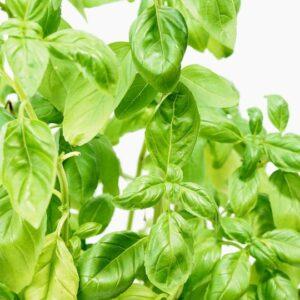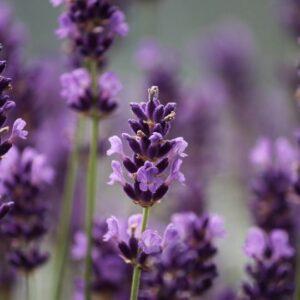4+1 medicinal and aromatic plants for every garden.
Cultivation tips.
By AgriSC scientific team.
There are many types of medicinal, aromatic plants. Let’s have a look at some of them below.

Did you know that?
The Egyptians used basil in embalming and the Christian custom of holy water with basil is probably due to the Gauls using the plant in purification ceremonies.
Basil or cross-flower
In general
Basil, one of the best-known medicinal and aromatic plants, has been used for its properties since ancient times. It is also said that St. Helena discovered the Holy Cross from the basil that grew where it was buried, hence the name cross flower. Its spread began in India, and its place of origin is thought to be the tropical regions of Africa and Asia.
It cultivates for culinary use and for making essential oil in the perfume industry. As a medicinal plant, it is used to combat headaches, diarrhoea, coughs, etc.
Cultivation
Due to its tropical and subtropical origin, the basil plant requires high temperatures and sufficient soil humidity, so you will often see it growing near springs or in places frequently watered. It grows best in an area with full sunlight. In shady spots, its leaves fade, and it sheds many. For its fertilization, the plant needs Nitrogen, Phosphorus, and Potassium in a ratio of 1:1:1 plus Magnesium. Organic fertilizer such as manure is recommended to intake the above elements. We must note that the phosphorus in all manures is much more assimilable than the phosphorus in inorganic fertilizers.
Rosemary
In general
Rosemary is one of the most important aromatic plants in Greek cuisine. It is famous since antiquity for its aroma and medicinal properties. It originates from southern Europe, mainly from Mediterranean countries, and is native to many areas of Greece.
Arismari, called Politeiki cuisine (from Constantinople), is used in cooking and cosmetology for making soaps, often together with lavender. Its oil is used externally for rubbing in myalgia and rheumatism and has a potent antioxidant and anti-inflammatory effect.
Cultivation
Rosemary is native to temperate and Mediterranean climates, likes mild, warm, and cool temperatures, and loves the sun. It is widely adapted to alkaline and acidic soils and has moderate water and nutrient requirements. Incorporating organic matter increases soil moisture and nutrient retention if your crop is dry. However, it is best to water 2-3 times during the summer. Fall and spring are appropriate periods to plant in your field or pot!

Did you know that?
The ancient Greeks used rosemary along with myrtle and laurel to make wreaths for the winners of games.

Did you know that?
Peppermint is said to be named after the nymph Mint, whom Pluto, the god of Hades, fell in love with and wanted to make her his lover. Persephone, his wife, and daughter of the goddess Dimitra, in her jealousy, transformed the daughter into a plant.
.
Spearmint & peppermint
In general
Mint and peppermint are two plants that are often confused, as they are similar. They belong to the same genus and come from Mediterranean countries, while mint comes from China. We can distinguish mint by the color and shape of its shoots, which are square with white fuzz and a dark violet color, unlike mint, whose shoots are green.
Spearmint is mainly used in cooking, and, like mint, its essential oil is used in the food, confectionery, perfumery, and aromatherapy industries. The decoction of both helps treat colds and effectively relieves various digestive problems.
Cultivation
Both plants require similar cultivation care. They grow best in areas with a temperate climate, mild winters, and not heavy summers. They require water, needing plenty of watering to withstand high summer temperatures. In addition to water, Mentha plants have high requirements for nitrogen fertilization, which can be provided with organic matter. In addition to nourishment, incorporating organic matter will help maintain soil moisture and pH balance.
Click here to learn about the difference between spearmint and mint.
Lavender
In general
Lavender, perhaps the best-known of the aromatic plants, is found in many regions of the Mediterranean. It prefers warmer climates and low-lying areas. Most lavender species originate from the Mediterranean basin and are found in rocky and limestone areas. The leading production countries are Bulgaria, England, Serbia, Australia, the USA, etc.
Lavender is cultivated mainly as an aromatic and ornamental plant. Its essential oil has insect-repellent and antioxidant properties and is also used to improve sleep.
Cultivation
Lavender needs well-drained soil, ideally sandy or gravelly, to avoid root rot and disease development. It loves the sun and has no special requirements for lubrication. As for irrigation in June and July, when the plant is in the flowering stage, it should not be left without water. Pruning (cutting off the flowers with part of the shoots) is recommended to strengthen the plant in the first two years. The flowers are collected when they are ripe, and the lower half is opened, while cutting should be avoided when it is hot and windy, as significant amounts of oil evaporate.
Click here to learn more about lavender.

Did you know that?
The name “lavender” comes from the Latin “lavare”, which means wash or swim, because the Romans used the purple flowers of the plant to perfume their baths.
If you are in an agronomy business, own an agronomy shop, and are seeking a collaboration opportunity with AgriSC, fill out the form below. Our team will respond promptly!
